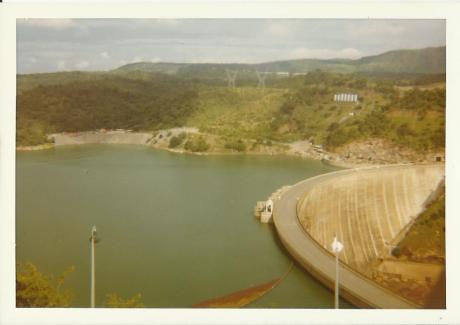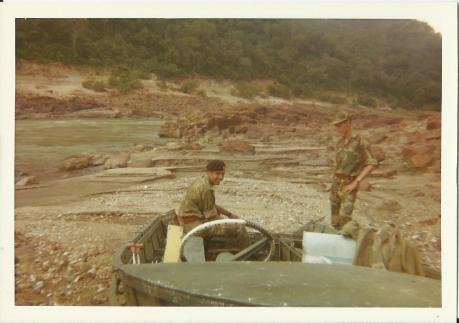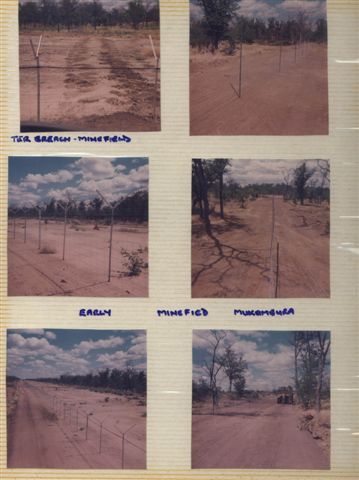On The Boats And Sundry Combat Engineer Duty: A Personal Account Of Rhodesian Sapper Life
May 2, 2015
Another great contribution by Basil Preston to my blog. Many thanks Basil.
Reading through this account, those of you that have been in the bush and taken part on ops will really get the feeling of having had similar experiences. I also worked with Don Price while at 1 Indep in Wankie and always found him to be a professional soldier although he did call me a “dude” one day while we doing stopper group ops for fire-force. Good times and I can really relate to Basils input which follows:
Boats at Binga and Sundry Combat Engineer’s duty 1978/79 (thereabouts)
We were doing a camp with 2RR?, at Binga and Major Don Price was the officer-in-charge. The Engineers were Stan Brazer, Graham Malone and myself and we were operating the boat in between doing mine-road clearance etc. We were to have a Pookie with us, but unfortunately it had been damaged in a mine blast before we arrived.
Major Don Price is well-known for his bush savvy and his company had many kills to their credit. But it was not always in their favour. Major Price was very strict; in that he would not allow any of his guys to catch a lift when their stint on patrol in the bush was complete. However, a stick of four guys had just completed their patrol and had stopped over at the police camp at Siabuwa, to wait for their pick up. (Siabuwa, is a small relatively unknown area and one would only know about it if one travelled to Karoi from Binga through the bush, along the southern edges of Kariba driving a 4×4. Nnear Binga, Matabeleland North, its geographical coordinates are 17° 28′ 0″ South, 28° 3′ 0″ East ). And the police camp was on top of a gomo.
(Inserted by Mark Craig: Below is a map showing Siyabuwa…….those following the blog will see how close it is to my area of boat operations).
Instead of the stick waiting for their pick-up at the pre-arranged position, they hitched a ride with the police in a landrover. However, the terrs had laid a mine in the tracks. And just before the police track entered the main dirt road, they hit the mine. Richard (?) Kashula and one/two other/s sitting in the back of the landy, where there is no mine protection were killed. John Sholts lost a leg. The one chap sitting in front of the landy plus the cop had minor injuries. The other guy was badly burnt from a white phosphorous grenade which had gone off in his back-pack at the time of the explosion. Kashula was an up and coming Rhodesian cricketer. My recollection of this is a bit hazy as far as the names go. But it was a sad day indeed for all of us.
We were all given a lambasting as to why the Major had rules and now we could all see what happens when ignored. We all felt shit….But then we all celebrated with the Major the good things they had done.
But life goes on. An Air Force chap, who was based at Binga at the same time had his private boat moored at the back harbour. Stan convinced him to take us fishing, which he gladly did. We tied the boat to a tree overhanging the water’s edge. This was at the mouth/entrance from the lake to the back harbour, as this guy said you catch “monsters” here. All we had to do was let the line out for a while, straight down; no casting, and then jiggle the line up and down. Stan had a strike which broke the rod where the reel is connected, but after recovering the line, all the tackle was gone. We all became very excited now, hoping to catch a “monster”.
But this was not to be. We had all been told to be on the look out for a Romanian chap, who supposedly ferried terrs across Kariba, and also that he had a 20mm cannon on his boat. Also, the odd police boat had been hijacked from its moorings and taken to the Zambian side from the front harbour. Hence why we now used the back harbour. {This was about the time the Janet was being used as the mother ship, with two strike boats operating from her. She had radar etc and were hoping to catch up with the Romanian. An Engineer, surname Tailor did his whole camp with one contact lens as the other had been blown out by the wind during a boat patrol.}
All of a sudden, bullets were zapping over our heads. We all shat ourselves, as we thought that the Romanian had seen us and was giving us a go. But the bullets stopped; then resumed again, and again. But the bullets were cracking rather high above us. Then we saw what was going on. The cops had floated a 44 gallon drum, and were doing “drive-by” firing practice at the drum, and the bullets were ricocheted off the water and ending up above us. We departed in a hurry and returned to the back harbour and safety (by road to the back harbour from Binga is about 15ks, and from the front harbour to the back harbour by boat, was about 30ks.)
We became rather friendly with the Air Force chap, based at Binga at the time, who loaned us his boat whenever we wanted a bit of R and R. But this soon came to a stop. We were going out on another R and R trip. And on arriving at the back harbour, we could not see the boat. But on closer inspection, we noticed the tie-up rope, and it was taught. We went closer and saw that it was still attached to the boat. It had sunk by itself. We were lost for any logical reason. Perhaps one of the cop’s bullets had done it an injury, but we will never know.
On another short patrol, this time in our Hercules, Graham Malone and I explored a part of the back harbour, which was off the beaten track so to speak (the army has given us plenty of opportunities of seeing “virgin” Rhodesia, which under normal circumstances one would never ever travel to and fishing sprees where no one has fished in years due to the terr activities. So this may sound like bullshit, but it is not). We were told that the tiger fish in the back harbour were a sub-species of the lake tiger; and were a smaller version and had a more snub head which was blueish in colour. But were just as sporty as the river tiger [the lake tiger is shorter and its girth bigger; is sluggish and basically only jumps once to rid itself of the hook.] (the record for a tiger in the lake is 42 lbs caught in a net, this is old information….1972…. and the river tiger is longer and more streamlined as it has to swim against currents etc and gives a better fight). We were able to confirm this sub species as we caught a few.
However, on a more humorous note, we were speeding along, and as we were rounding a bend, we surprised a hippo, which normally are not on land during day time, but this area was human-free and I doubt whether the hippo had ever seen a boat before. Not only did we surprise this huge animal, it put the shits up us, as we had not seen it. But all of a sudden, we heard this thrashing sound of something hitting water at speed. When we saw it, it was a mass of moving, terrified animal pushing water either side of itself, similar to when a Kariba sluice gate is open full. And it was heading directly towards us, well that’s what we thought. It was charging along the shortest route to get back into the water and safety. We were out of there in no time. It is just a pity that we did not have a camera with us. But I doubt whether any of us could have taken a picture, as things were happening at a terrific speed.
One night Don Price sent us on a night ambush. We were to ambush the bottle store (Tolotsho Bottle Store, I think, as intel from BSAP Special Branch had heard that the terrs were going to have a beer drink) about 30ks from Binga, back on the main road towards Kamativi. It was full moon and we were being driven by Louis Ribero. A whizz at de-governing the TCVs. As usual, the old Bedfords always back-fired, but Louis could make this happen as if it was a natural noise of the truck; so just after passing where we were to have the ambush, he induced the Bedford to back-fire, and slowed down so that we could hop off without killing ourselves, and once we were all off, the vehicle suddenly recovered and he continued for a couple of k’s so that the terrs would not know that we had hopped off. Then he turned and set off back to Binga and a cold chibulie.
About 15 minutes after being dropped off, we heard this tremendous explosion. Things always sound much louder at night. We all knew that Louis had hit a mine. The terrs (obviously on their way to the beer drink) had put one down just after we had passed them. They could have ambushed us. Anyway, we were then told to hump it back and ambush the truck. Also, a Provost was being sent from Wankie to drop a flare in order for us to have a look-see around the truck etc.
But, the timing was out. Ribero had been going so fast that the Major had incorrectly estimated the time it would take us to get into position and be able to use the light from the flare. Louis had told the Major that the old Bedford could not speed. Anyway, the plane flew over head, dropped his flare and we were still miles away.
Our adrenaline was pumping and as one knows, induces plenty of pissing time, and I just stepped off the main road onto the verge; we did not stop, so when I rejoined the line, a Rifleman nearly took me out as he had not seen me step aside. I learnt another lesson that night. Make sure everyone knows where every one is at all times.
Anyway, we eventually arrived at the RL, we could see enough to confirm that Louis was speeding; fortunately for him, it was on a straight and it was a right-back wheel detonation and no injuries, other than Louis’s pride. His truck was airborne for about 50 metres before the back axle touched down again. Another RL from the camp had already fetched Louis and his escorts before we arrived back at the injured old RL (the terrs had learnt too that when an RL back-fires that we were setting up something and the vehicle had to return, they were not all stupid as one thought and used this opportunity to plant a surprise, this was done on many occasions to other chaps).
We could not see all that good, but good enough to choose a spot for our ambush and then crept into our fart-sacks and did guard, by touching the guy next to you when your stint was over. However, my fear of Kariba spiders was with me again. After I crept into my sleeping bag, and just above my head, I saw this huge spider. The type that eats innocent Sappers. I did not move much for fear that this spider would make me his nightly snack.
I did eventually fall asleep, and when my eyes opened, the first thing I did was to see where the spider was (it’s funny how the mind works; bushes start moving, all shapes become the enemy, etc.). Well, I had been stressed for nothing, as the huge spider was in fact the head of a grass seed, the size of a semi-closed hand. I was thankful that I had not shared this with anyone that night, as I would not have heard the end of it. But perhaps they also had their own spiders to contend with.
And Louis Ribero continued to drive like Speedy Gonsalas. And survived, I hope, as he was a pleasant character.
Sapper B.R.Preston (RhE); 72860
Please also have a look at my website dedicated to Rhodesian and South African Military Engineers. Please join us on the forums by using the following link:
http://www.sasappers.net/forum/index.php
Copyright
© Mark Richard Craig and Fatfox9’s Blog, 2009-2015. Unauthorised use and/or duplication of this material without express and written permission from this blog’s author and/or owner is strictly prohibited.















